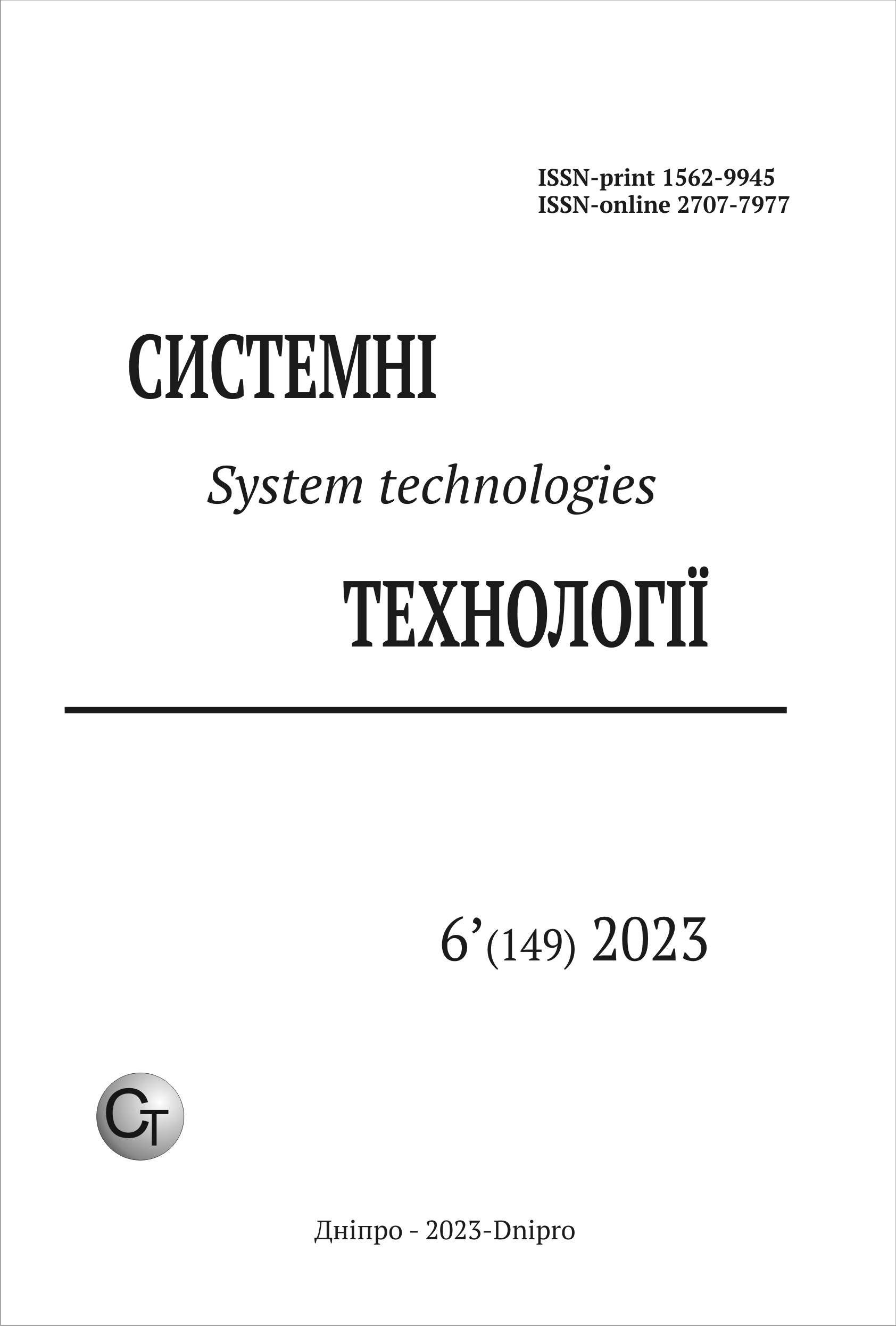ВЛАСТИВОСТІ МЕТОДІВ ОБРОБКИ ТА ОТРИМАННЯ ДАНИХ В ТЕСТ-МЕТОДАХ ХІМІЧНОГО АНАЛІЗУ
DOI:
https://doi.org/10.34185/1562-9945-6-149-2023-04Ключові слова:
обробка результатів, сканер-індикація, камера смартфону, експрес-аналіз, аналітичний сигнал, точка інтересу, тест-методи.Анотація
Сканерна індикація аналітичного сигналу в хімічному аналізі – це об’єктивний, швидкий і автоматизований спосіб оцінки кольорових характеристик забарвлених зразків. Використання сканерної індикації при отриманні АС позбавляє від помилок, пов'язаних із суб'єктивної оцінкою та допомагає людям з вадами кольорового зору, прискорює операції збору та обробки інформації. Врахування та контроль джерела світла в скануючих системах є ключовим для забезпечення стабільності та точності отриманих зображень у різних умовах освітлення. Для отримання аналітичного сигналу першочергово необхідно обробити зображення для отримання області інтересу, який визначається методом сегментації, ручним методом та використовуючи ШІ. Аналіз отриманих значень проводиться шляхом побудови лінійної або нелінійної залежності значення кольору в обраній кольоровій моделі приведений до єдиного значення АС до концентрації.
Посилання
L.F. Capitán-Vallvey, N. López-Ruiz, A. Martínez-Olmos, M.M. Erenas, A.J.Palma, Recent Developments in Computer Vision-Based Analytical Chemistry: A Tutorial Review, Analytica Chimica Acta (2015), doi: 10.1016/j.aca.2015.10.009.
V. Oncescu, D. O'Dell, D. Erickson, Smartphone based health accessory for colorimetric detection of biomarkers in sweat and saliva, Lab Chip 13 (2013)
-38.
C.A. Chaplan, H.T. Mitchell, A.W. Martinez, Paper-based standard addition assays, Anal.Methods 6 (2014) 1296-300.
Z. Iqbal, R.B. Bjorklund, Colorimetric analysis of water and sand samples performed on a mobile phone, Talanta 84 (2011) 1118-23.
K. Cantrell, M.M. Erenas, I. Orbe-Paya, L.F. Capitan-Vallvey, Use of the Hue Parameter of the Hue, Saturation, Value Color Space as a Quantitative Analytical Parameter for Bitonal Optical Sensors, Anal.Chem. 82 (2010) 531-42
Q. Wei, R. Nagi, K. Sadeghi, S. Feng, E. Yan, S.J. Ki, R. Caire, D. Tseng, A. Ozcan, Detection and Spatial Mapping of Mercury Contamination in Water Samples Using a Smart-Phone, ACS Nano 8 (2014) 1121-29.
A. Garcia, M.M. Erenas, E.D. Marinetto, C.A. Abad, I. de Orbe-Paya, A.J. Palma, L.F. Capitan-Vallvey, Mobile phone platform as portable chemical analyzer, Sens.Actuators B 156 (2011) 350-59.
M. Ariza-Avidad, A. Salinas-Castillo, M.P. Cuellar, M. Agudo-Acemel, M.C. Pegalajar, L.F. Capitan-Vallvey, Printed Disposable Colorimetric Array for Metal Ion Discrimination, Anal.Chem. 86 (2014) 8634-41.
D. Lee, W.P. Chou, S.H. Yeh, P.J. Chen, P.H. Chen, DNA detection using commercial mobile phones, Biosens.Bioelectron. 26 (2011) 4349-54.
V.F. Curto, C. Fay, S. Coyle, R. Byrne, M. O'Toole, C. Barry, S. Hughes, N. Moyna, D. Diamond, F. Benito-Lopez, Real-time sweat pH monitoring based on a wearable chemical barcode micro-fluidic platform incorporating ionic liquids, Sens.Actuators B 171-172 (2012) 1327-34.
V.V. Apyari, S.G. Dmitrienko, Using a digital camera and computer data processing for the determination of organic substances with diazotized polyurethane foams, J.Anal.Chem. 63 (2008) 530-37.
S.V. Bannur, S.V. Kulgod, S.S. Metkar, S.K. Mahajan, J.K. Sainis, Protein Determination by Ponceau S Using Digital Color Image Analysis of Protein Spots on Nitrocellulose Membranes, Anal.Biochem. 267 (1999) 382-89.
M.M. Mentele, J. Cunningham, K. Koehler, J. Volckens, C.S. Henry, Microfluidic Paper-Based Analytical Device for Particulate Metals, Anal.Chem. 84 (2012) 4474-80.
T. Soga, Y. Jimbo, K. Suzuki, D. Citterio, Inkjet-Printed Paper-Based Colorimetric Sensor Array for the Discrimination of Volatile Primary Amines, Anal.Chem. 85 (2013) 8973-78.
R.C. Murdock, L. Shen, D.K. Griffin, N. Kelley-Loughnane, I. Papautsky, J.A. Hagen, Optimization of a Paper-Based ELISA for a Human Performance Biomarker, Anal.Chem. 85 (2013) 11634-42.
A. Choodum, N. Nic Daeid, Rapid and semi-quantitative presumptive tests for opiate drugs, Talanta 86 (2011) 284-92.
A. Abbaspour, A. Khajehzadeh, A. Noori, A simple and selective sensor for the determination of ascorbic acid in vitamin C tablets based on paptode, Anal.Sci. 24 (2008) 721-25.
F.G. Souza, Jr., G.E. Oliveira, T. Anzai, P. Richa, T. Cosme, M. Nele, C.H.M. Rodrigues, B.G. Soares, J.C. Pinto, A Sensor for Acid Concentration Based on Cellulose Paper Sheets Modified with Polyaniline Nanoparticles, Macromol.Mater.Eng. 294 (2009) 739-48.
S. Sumriddetchkajorn, K. Chaitavon, Y. Intaravanne, Mobile device based self-referencing colorimeter for monitoring chlorine concentration in water, Sens.Actuators B 182 (2013) 592-97.
C. Zhang, K.S. Suslick, Colorimetric Sensor Array for Soft Drink Analysis, J.Agric.Food Chem. 55 (2007) 237-42.
Завантаження
Опубліковано
Номер
Розділ
Ліцензія
Авторське право (c) 2024 Системні технології

Ця робота ліцензується відповідно до ліцензії Creative Commons Attribution 4.0 International License.















